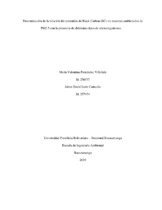| dc.contributor.advisor | Mágara Gómez, Kento Taro | |
| dc.contributor.author | León Camacho, Johan David | |
| dc.contributor.author | Fernández Villafañe, María Valentina | |
| dc.coverage.temporal | 2019 | |
| dc.date.accessioned | 2020-12-07T16:47:52Z | |
| dc.date.available | 2020-12-07T16:47:52Z | |
| dc.date.issued | 2019-07 | |
| dc.identifier.uri | http://hdl.handle.net/20.500.11912/7138 | |
| dc.description | 79 páginas | spa |
| dc.description.abstract | En el presente trabajo se determinó la relación existente entre el Black Carbon y diferentes grupos de microorganismos, ambos presentes en el material particulado de la Universidad Pontificia Bolivariana seccional Bucaramanga, con el fin de evidenciar una relación positiva o negativa entre el BC y los microorganismos presentes en la microbiota del aire. En dicho estudio
se realizaron tomas de muestras ambientales atmosféricas mediante el equipo URG 3000ABC durante un periodo de 4 semanas correspondientes al mes de marzo del presente año. Se realizaron análisis de determinación de concentraciones de material particulado, contenido de Black Carbon presente e identificación de grupos fúngicos y descripción de colonias bacterianas.
Los resultados arrojaron similaridad entre las concentraciones de PM 2.5 en ambas zonas
debido a la influencia de un fenómeno regional que aumentó las concentraciones de partículas de aerosol atmosférico durante el periodo de muestreo, dichas concentraciones llegaron a presentar niveles superiores y/o cercanos a la máxima permisible de 37 μg/m3 establecida por la resolución 2254-2017 de minambiente. Se obtuvo una diversidad microbiológica bacteriana
con predominancia en característica microscópica perteneciente al grupo de Bacilos Gram + seguidos de Bacilos Gram + esporulados y en menor medida Bacilos Gram – y cocos Gram +.
La diversidad microbiológica correspondiente para el grupo fúngico varía entre especies del
género Aspergillus y Rhizopus; también se encuentra dentro de este grupo dos especies de hongo no identificable mediante la metodología usada. Debido a la similaridad entre las concentraciones de PM 2.5 no se evidencia una relación entre las concentraciones de dicho material, con la diversidad microbiológica, a diferencia de las concentraciones de black carbon, en las cuales se observa una disminución en la diversidad de especies de hongos a medida que las concentraciones del BC aumentan. | spa |
| dc.description.abstract | In the actual research work, the relationship between Black Carbon and different groups of microorganisms, both present in the particulate material of the Universidad Pontificia Bolivariana Bucaramanga section, was determined in order to demonstrate a positive or negative relationship between the BC and microorganisms present in the microbiota of the air. In this study, atmospheric environmental samples were taken by the URG 3000ABC team during a period of 4 weeks corresponding to the month of March of this year. Analyzes of determination of results of particulate material, black carbon content, identification of fungal groups and description of bacterial colonies were carried out. The results showed a similarity between the results of PM
2.5 in both areas due to the influence of a regional phenomenon on the results of atmospheric aerosols during the sampling period, to the contents at levels above and/or close to the maximum Permissible 37 μg/m3 established by resolution 2254-2017 of minambiente. Bacterial microbiological diversity was obtained with predominance in the microscopic characteristic belonging to the group of Gram + Bacillus followed by Gram + Bacillus esporulados and to a lesser extent Bacillus Gram - and Gram + cocci. The microbiological diversity for the fungal group
between the species of the genus Aspergillus and Rhizopus; Two non-identifiable fungus species are also found within this group, using the methodology used. The information is based on information from PM 2.5. There is no evidence of a relationship between the forms of said material, the microbiological diversity, the difference in the amount of black carbon, in which a decrease in the diversity of fungal species is observed. A measure that the BC figures increase. | eng |
| dc.format.mimetype | application/pdf | |
| dc.language.iso | spa | |
| dc.publisher | Universidad Pontificia Bolivariana | spa |
| dc.rights | Attribution-NonCommercial-NoDerivatives 4.0 International | * |
| dc.rights.uri | http://creativecommons.org/licenses/by-nc-nd/4.0/ | * |
| dc.subject | Microorganismos | spa |
| dc.subject | Black carbón | spa |
| dc.subject | Bacterias | spa |
| dc.subject | Hongos | spa |
| dc.subject | Material particulado | spa |
| dc.title | Determinación de la relación del contenido de Black Carbon (BC) en muestras ambientales de PM2.5 con la presencia de diferentes tipos de microorganismos | spa |
| dc.type | Trabajo de grado | spa |
| dc.publisher.department | Escuela de Ingenierías | spa |
| dc.publisher.program | Ingeniería Ambiental | spa |
| dc.type.hasVersion | publishedVersion | spa |
| dc.description.sectional | Bucaramanga | spa |
| dc.description.degreename | Ingeniero Ambiental | spa |


